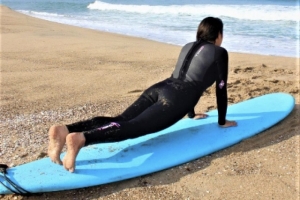A great introduction to the basics of surfing. Approximately 20 mins of beach training followed by 90 mins of surfing. All equipment included.
Tip 2 - The Dreaded Paddle Out!
The one thing newbies struggle with is paddling out.
The majority just point for the horizon and flail their arms at speed until they hurt, followed by a breathless dismount in knee depth of water - sound familiar?
OK, before you even get on your board make sure you walk to at least chest depth, then climb on a couple of inches further than you would for a normal wave catching position (you can't nose dive while paddling out). Look ahead not down, keep your feet up so they don't drag, keep your body rigid, only move your arms to paddle. Rocking side to side when paddling means over reaching = no glide = slow, so quit that and shorten the stroke length. Now find a rhythm you can maintain, remember smooth = fast.
Now you have to deal with a wave, forget duck dives, rolling etc, we are simply going to push over the wave to conserve energy. So increase paddling speed as the wave approaches, then at the very last second place both hands in line with your shoulders, put your toes on the tail and do a push up as the wave hits you (see pic). The goal is to get the flow of water between you and the board (path of least resistence) and not take it straight to the face/chest - which creates a big impact area and results in your return to shore backwards AKA the bongo slide. Once the wave has passed, start paddling, do not sort the hair/snot/dribble, get paddling!
Once you've reached your destination, sit up and breathe, don't paddle for the first wave you see. Turn the board so you're facing the beach and ............
Wait for Tip 3 on wave catching !
Gift Vouchers
Why not treat a loved one to the best present of them all - a surfing lesson!















